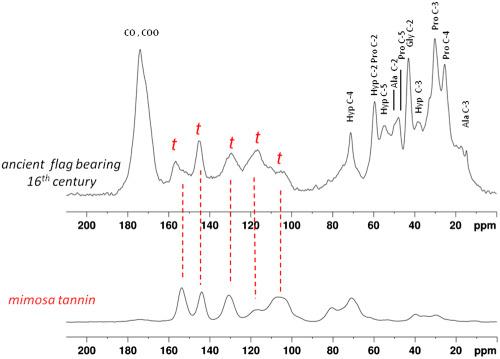当前位置:
X-MOL 学术
›
Magn. Reson. Chem.
›
论文详情
Our official English website, www.x-mol.net, welcomes your feedback! (Note: you will need to create a separate account there.)
13 C Solid State NMR complemented by ATR-FTIR and micro DSC to study modern collagen based material and historical leather
Magnetic Resonance in Chemistry ( IF 2 ) Pub Date : 2020-04-06 , DOI: 10.1002/mrc.5024 Noemi Proietti 1 , Valeria Di Tullio 1 , Cristina Carsote 2 , Elena Badea 3, 4
Magnetic Resonance in Chemistry ( IF 2 ) Pub Date : 2020-04-06 , DOI: 10.1002/mrc.5024 Noemi Proietti 1 , Valeria Di Tullio 1 , Cristina Carsote 2 , Elena Badea 3, 4
Affiliation

|
Ancient vegetable tanned leathers and parchments are very complex materials in which both different manufacturing and deterioration processes make their study and chemical characterization difficult. In this research, solid state NMR spectroscopy was applied to identify different tannin families (condensed and hydrolyzable) in historical leather objects such as bookbindings, wall upholsters, footwear and accessories, and military apparel. Furthermore, leather deterioration with special focus on collagen gelatinization was investigated. A comparison with FTIR spectroscopy and micro DSC was also performed to support the 13 C CP-MAS NMR findings and to point out the advantages and limitations of solid-state NMR in analyzing historical and archeological leathers. A wide database of NMR and FTIR spectra of commercial tannins compounds was also collected in order to characterize historical and archaeological leathers.
中文翻译:

13 C 固态 NMR 辅以 ATR-FTIR 和微型 DSC,用于研究现代胶原基材料和历史皮革
古代植鞣革和羊皮纸是非常复杂的材料,不同的制造和变质过程使它们的研究和化学表征变得困难。在这项研究中,固态 NMR 光谱被应用于识别历史皮革制品(如书籍装订、墙饰、鞋类和配饰以及军装)中的不同单宁家族(缩合和可水解)。此外,研究了特别关注胶原凝胶化的皮革劣化。还进行了与 FTIR 光谱和微型 DSC 的比较,以支持 13 C CP-MAS NMR 的发现,并指出固态 NMR 在分析历史和考古皮革方面的优势和局限性。
更新日期:2020-04-06
中文翻译:

13 C 固态 NMR 辅以 ATR-FTIR 和微型 DSC,用于研究现代胶原基材料和历史皮革
古代植鞣革和羊皮纸是非常复杂的材料,不同的制造和变质过程使它们的研究和化学表征变得困难。在这项研究中,固态 NMR 光谱被应用于识别历史皮革制品(如书籍装订、墙饰、鞋类和配饰以及军装)中的不同单宁家族(缩合和可水解)。此外,研究了特别关注胶原凝胶化的皮革劣化。还进行了与 FTIR 光谱和微型 DSC 的比较,以支持 13 C CP-MAS NMR 的发现,并指出固态 NMR 在分析历史和考古皮革方面的优势和局限性。


























 京公网安备 11010802027423号
京公网安备 11010802027423号